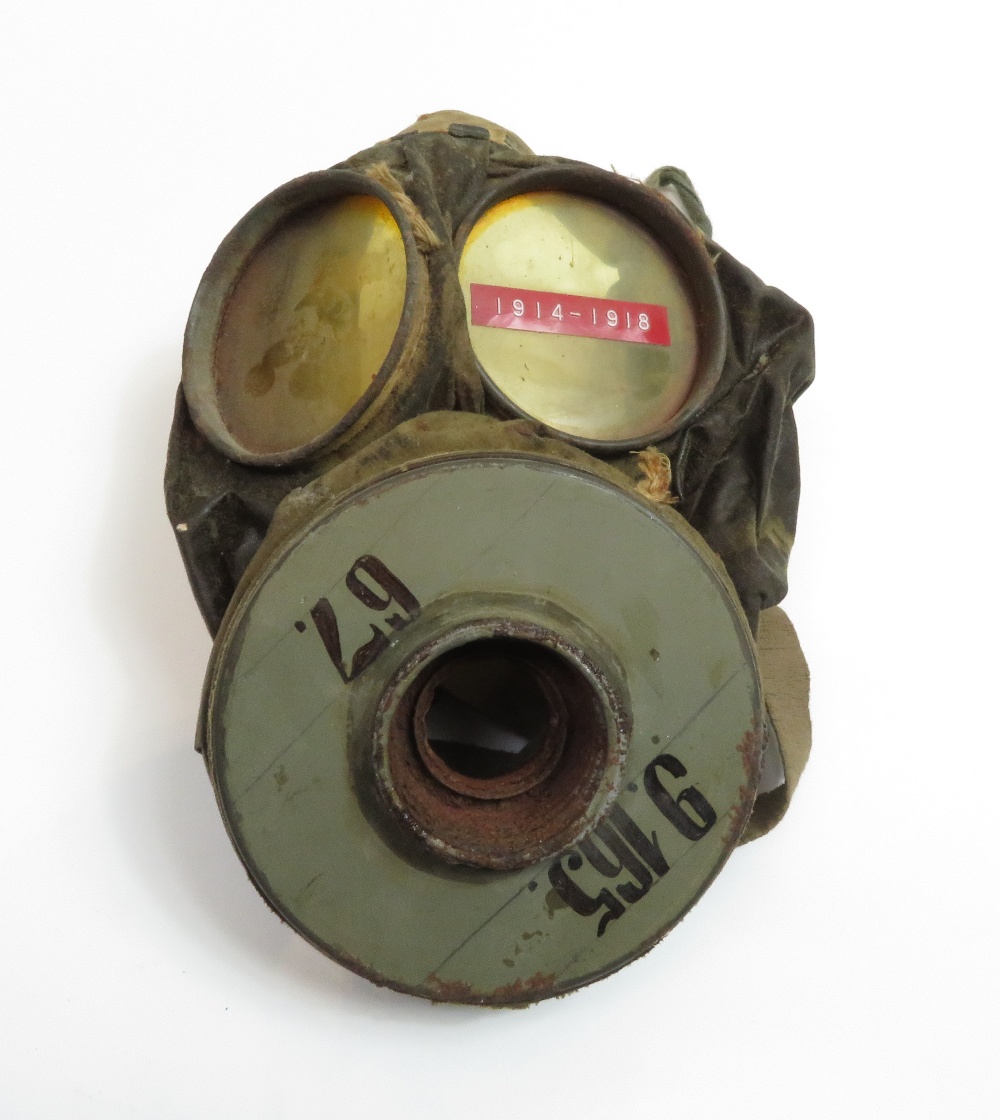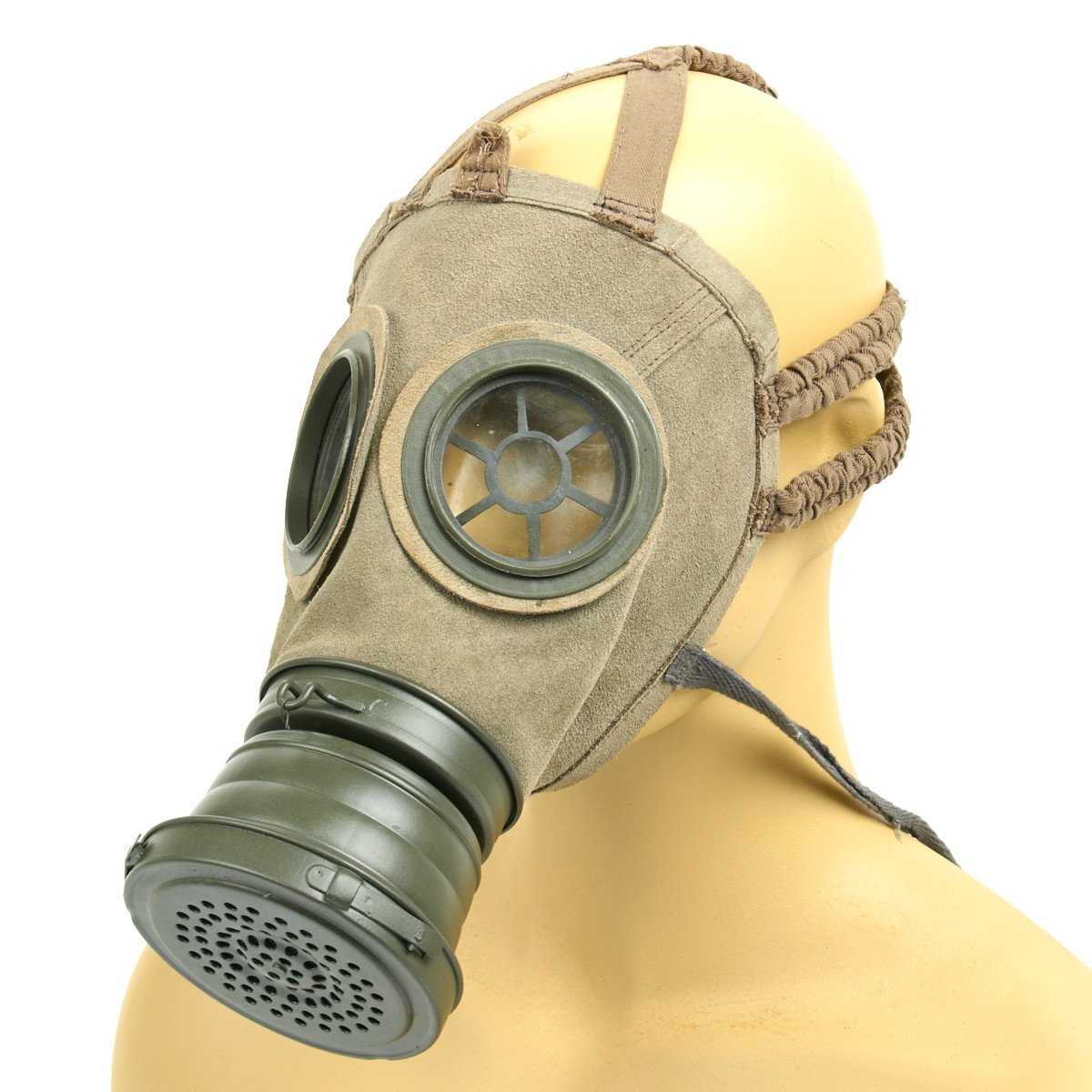
The gas mask carry case was known as a 'Lederschutzmaske (Bereitschaftsbuchen)'. These were removed on the improved Gasmaske 18. The spoked metal devices on the inside of both lenses were known informally as 'spiders'. Sometimes referred to as 'model 1917', after the year of its introduction, this style of gas mask was also known as the 'Ledermaske (Gasmaske 17)'. The Germans used both leather 'leder' and rubber 'gummi' masks during the First World War. At the top of the canister mount, along the middle of the gas mask is a hook for the attachment of a length of ersatz paper cord (which is missing) which is normally threaded between the eyes to a leather loop on the gas mask above the forehead of the wearer. The bottom of the canister is heavily rusted and through these rusted holes can be seen some of the white coloured filter lining. The remnants of a small manufacturer's stamp are also barely visible. On the canister is stamped in faded blue ink '9u'. When the canister is removed an embossed 'H2' can be seen on the outside circular metal mounting surface of the mask. A long khaki cotton webbing strap attached near the chin enables the mask to be suspended around the neck.Ī rusted and scratched grey-green canister filter unit is attached to the mask. Khaki cotton head straps are connected to coiled springs inside cotton sleeves to keep mask in place. The right 'spider' fitted to the mask has some of the inner circular metal piece missing. Internally, the eyepieces have removable metal 'spiders' enabling the inner layer (which was coated with gelatine to absorb moisture) to be replaced.

The circular eyepieces are made of two layers of yellowed celluloid, set in painted circular steel frames with leather gaskets where they are let into the mask. The single seam running under the chin and the folded edge of the mask are coated with a black sealant lacquer partially made from rubber.

The mask is made from a single piece of chrome-tanned sheepskin dipped in an oil sealant solution. The war showed this rational to be entirely wrong and rifles and bayonets became much shorter after the war, and after WW2 much shorter again.German 'Lederschutzmaske' (Leather protection mask) gas mask. They were made that length so that an infantryman or artilleryman could use it to fight a cavalryman who was using a sword from horse back. But not produced as a module attached to the face piece until after the war.įor a great deal of WW1 equipment - its a case of looking at it and asking "why did they make it like that ?" and frequently the answer is, what to us is the obviously better design was simply not identified and introduced until after the war. A very good design - simple, reliable, robust, minimal number of parts and very cheap to make. The valve will give minimal flow resistance as the wearer exhales but will automatically seal closed when the wearer inhales. This round cover will be protect a circular "flutter valve", a soft rubber disk held I place by a stud through the centre of the disk and resting on a seat like a tap seat. Very hard to tell from the photo, but to me the cover of the exhaust valve is stamped, tinplate sheet steel not plastic. To allow the wearer to breathe more easily, the mask was reduced in size to lessen the volume of air within, and the mask's filter plate was therefore noticeably reduced in diameter. Known as the Rahmenmaske, it was introduced sometime around the spring to late summer of 1916 (sources don't agree on this point). The mask shown on the right is the third model Gummimaske. An example of this mask, shown below left, retains the early 11-11S three layer filter. The second model Gummimaske, known as the Bandmaske, was the first gas mask to have a screw-in filter, which meant it could be replaced during a gas attack.

Due the short period of time that they were manufactured and used, and the fact that the early single layer filter proved unsuccessful, they are exceptionally rare. This version was known as the Linienmaske.

The very first version of the Gummimaske was introduced sometime between August and September 1915. I'll start a separate thread on the later M17 leather gas masks. I thought I'd start a thread on German rubberized cloth gas masks (Gummimasken) and their carriers, and share some examples that I've found over the past 8 years.


 0 kommentar(er)
0 kommentar(er)
